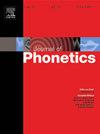加拿大英法双语者的社会语音学研究:跨语言、性别和年龄的吱吱声
IF 2.4
1区 文学
0 LANGUAGE & LINGUISTICS
引用次数: 0
摘要
本文研究了不同语言、性别和出生年份的声音吱吱声的声学相关性,以探讨1)语音质量跨语言差异的可靠性,2)性别差异的方向和程度,以及3)是否存在针对语音质量的持续声音变化。从公开的在线数据源收集了49名加拿大英法双语者的自发演讲。该语料库经过处理,并使用带有手动检查的自动化管道提取了一系列语音质量的声学测量。结果没有显示出强有力的或一致的证据表明跨语言差异的吱吱声。在性别方面,男性的声音明显更刺耳,表现为更不可靠的f0音轨、更低的H1* -H2 *、更低的CPP和更低的HNR <;500赫兹。至于年龄,结果通常显示老年演讲者,CPP和HNR <;500hz值随着YOB的增加而增加,而其他声学测量没有显着差异,这表明这些影响更可能是由于声音老化而不是声音变化。与流行的看法和最近的研究声称年轻女性是使用沙哑声音的领导者相反,这项研究发现与沙哑相关的声学结果恰恰相反:男性的声音更沙哑,如果有的话,年轻的说话者不那么沙哑。这一差异的可能原因,回顾最近的知觉工作的声音吱吱,讨论。本文章由计算机程序翻译,如有差异,请以英文原文为准。
A sociophonetic study of creaky voice across language, gender and age in Canadian English-French bilinguals
This paper examines the acoustic correlates of creaky voice across language, gender and year of birth to investigate 1) the reliability of cross-linguistic differences in voice quality, 2) the direction and extent of gender differences with respect to creaky voice, and 3) the existence of an ongoing sound change targeting voice quality. Spontaneous speech from 49 Canadian English-French bilingual speakers was collected from publicly available online data sources. This corpus was processed and a range of acoustic measures of voice quality extracted using an automated pipeline with manual checks. Results do not show strong nor consistent evidence for cross-linguistic differences in creak. Regarding gender, men’s voices are unequivocally creakier, indicated by more unreliable f0 tracks, lower H1*–H2*, lower CPP and lower HNR < 500 Hz. As for age, results generally show more creak for older speakers, CPP and HNR < 500 Hz values increasing with YOB while other acoustic measures show no significant differences, suggesting that these effects are more likely due to vocal aging than sound change in progress. Contrary to popular perception and recent work claiming that young women are leaders in creaky voice use, this study finds that acoustic correlates of creak show the exact opposite: men’s voices are creakier and if anything, younger speakers are less creaky. Possible reasons for this discrepancy, reviewing recent perceptual work on creaky voice, are discussed.
求助全文
通过发布文献求助,成功后即可免费获取论文全文。
去求助
来源期刊

Journal of Phonetics
Multiple-
CiteScore
3.50
自引率
26.30%
发文量
49
期刊介绍:
The Journal of Phonetics publishes papers of an experimental or theoretical nature that deal with phonetic aspects of language and linguistic communication processes. Papers dealing with technological and/or pathological topics, or papers of an interdisciplinary nature are also suitable, provided that linguistic-phonetic principles underlie the work reported. Regular articles, review articles, and letters to the editor are published. Themed issues are also published, devoted entirely to a specific subject of interest within the field of phonetics.
 求助内容:
求助内容: 应助结果提醒方式:
应助结果提醒方式:


